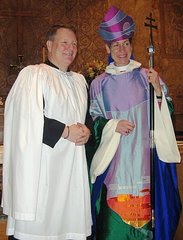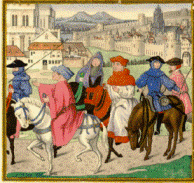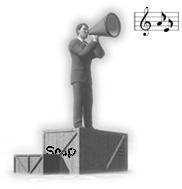 The Altar Steps by Compton Mackenzie
The Altar Steps by Compton Mackenzie
One of the joys of auditing a course means that you can head down ‘rabbit holes’ in the assigned reading when they attract your attention, and not have to worry about it. In doing some reading for my Modern Anglican Development class, I came across an article originally published in Victorian Studies on Anglo-Catholicism and homosexuality by David Hilliard. The article made reference to Sir Compton Mackenzie’s Anglo-Catholic trilogy of novels. Down the rabbit hole I went.
Mackenzie is most noted for his comic novels of the 1940s Monarch of the Glen and Whiskey Galore set in Scotland. However, earlier in his career, he was seen as a literary novelist and was greatly admired by F. Scott Fitzgerald. Mackenzie was admird for, among other works, his coming of age Sinister Street novel (in 2 volumes), which were compared to W. Somerset Maugham’s Of Human Bondage. Mackenzie’s Anglo-Catholic trilogy of novels -- The Altar Steps, The Parson’s Progress and Heaven’s Ladder -- are another bildungsroman flavored effort on Mackenzie’s part. The main character Mark Lidderdale is, like Mackenzie, deeply religious. And his development as a burgeoning catholic is charted by the three novels. I found a free online copy of The Altar Steps, downloaded it, printed it out and red it through. In the opening chapters of the book, it is the late 19th century and Mark’s father James, an Anglican priest, has come to St. Simon’s Notting Hill, an outpost of the Catholic Movement in the Church of England. Fr. Lidderdale is given charge of the St. Simon’s Lima Street Mission. The Lima Street Mission typifies the outreach to working class and poor constituents that was a marked aspect of the Catholic Revival. James Lidderdale falls afoul of the bishop with a Mass of the Pre-Sanctified and a ceremony of Creeping to the Cross on Good Friday, among other Ritualist practices. His conflict with the bishop brings on a bout of rage and self-pity. He rants that his lack of fealty to his vow of celibacy as a catholic priest has caused this downfall, and he rejects Mark and his mother, and leaves for missionary work in Africa.
In the opening chapters of the book, it is the late 19th century and Mark’s father James, an Anglican priest, has come to St. Simon’s Notting Hill, an outpost of the Catholic Movement in the Church of England. Fr. Lidderdale is given charge of the St. Simon’s Lima Street Mission. The Lima Street Mission typifies the outreach to working class and poor constituents that was a marked aspect of the Catholic Revival. James Lidderdale falls afoul of the bishop with a Mass of the Pre-Sanctified and a ceremony of Creeping to the Cross on Good Friday, among other Ritualist practices. His conflict with the bishop brings on a bout of rage and self-pity. He rants that his lack of fealty to his vow of celibacy as a catholic priest has caused this downfall, and he rejects Mark and his mother, and leaves for missionary work in Africa.
Young Mark and his mother return to Cornwall, and to the care of his benevolent, more protestant, priest-grandfather. Mark is sent to an uncle to be educated in his private, very evangelical boy’s school Haverton House. After a few years Mark runs afoul of his uncle and what Mackenzie calls “his desiccated religion.” On Whit-Sunday (Penetecost: day of the coming of the Holy Spirit) on a walk in the fields, Mark is drawn by church bells to an Anglo-Catholic parish nearby. Mark is swept up in the piety of his childhood by the Sanctus, the Nicene Creed, and the mystery of the mass. He becomes friendly with the vicar, Stephen Ogilvie, and his mother and sisters, and comes into the Ogilvie family’s orbit for the rest of the novel.
Mark is confirmed at Fr. Ogilvie’s church at Meade Cantorum and decides to become a priest. The vicar tutors him in classics and eventually Mark sits for scholarship exams at Oxford. However, in a fit of self-sacrifice he deliberately fails his exams in favor of a less fortunate student. Still set on the priesthood, Mark makes a vow of celibacy and seeks to occupy his time until he can enroll in theological college and qualify for ordination.
In the ensuing year’s Mark lives and works at an Anglo-Catholic mission much like the one his father ran. Here at Chatsea, Mark is tutored by Fr. Rowley, an avid Anglo-Catholic, and selfless missioner to the poor fishing and merchant marine families of the seaside village. Fr. Rowley is widely admired for his work, and by subscription and exhaustive fundraising, he builds a magnificent parish church in Chatsea. However, a new bishop is unwilling to license the church with its Altar of the Dead, where masses are to be offered for the salvation of the souls of the many dead sailors from the community. This flagrantly catholic practice cannot be sanctioned and Fr. Rowley, much like Mark’s own father, abandons his ministry rather than compromise his principles.
Mark decides to be an itinerant preacher, and eventually lands in one of the newly refounded Anglican monasteries. The Order of St. George struggles to pursue its mission when its founder and leading light must constantly travel, preach and fundraise. It is meant to be a mission to sailors, but must close its portside priories and retreat to its mother house to await brighter days. The novices and monks are by turns truly devout and foolishly distracted by the ethereal ceremonies of monastic life and profession. At the end of the novel, Mark leaves the order and rededicates himself to his priestly vocation.
The novel brings to life the conflicts that arose out of Anglo-Catholic revival in Anglicanism as they confronted the movement’s second generation. Mark’s own father and his mentor Fr. Rowley both seek to bring pastoral comfort to their poor communities through Anglo-Catholic liturgy, and catholic theology and piety. Both men are eventually countered by short-sighted, conservative bishops who tout the letter of ecclesial law, and ignore the enormous good that these priests are doing.
The Anglo-Catholic social ministry is foremost in Mackenzie’s view of the movement. The author has great approbation for the devotion these men had to the poor communities that were often the only one’s that would accept their theological and liturgical catholicism. Fr. Rowley’s devotion to his Altar for the Dead, and the deep meaning it held for his parishioners who scrimped and saved to build it, is profound and moving.
Anglo-Catholic monasticism is given less praise as the fictional Order of St. Paul is made to seem at best misguided and unsuccessful, and at worst frivolous. And our hero Mark makes mistakes along his way to spiritual maturity. In an hilarious episode, he attempts to kidnap an evangelical MP’s son and spirit him away to an Anglo-Catholic vicarage where he can be safely converted to the catholic faith and practice. His effort is discovered and thwarted, but we see the sometime overlap and interplay of ecclesial and secular politics.
As the novel concludes, in a nice turnabout, Mark has learned that he is to be ordained, and his first  reflections are on what he will preach the next Sunday -- not on what vestments he’ll wear or rituals he’ll enact. Mackenzie clearly has a high regard for the seriousness of the Catholic Movement, and great sympathy for it. His novel’s chief value for me was its from-the-inside view of the Anglo-Catholic movement. One comes to feel some of the sincerity and piety of the movement’s proponents along with the indignation they feel at evangelicalism efforts to thwart their piety and devotion. The bright line that divided evangelical and Anglo-Catholic practice
reflections are on what he will preach the next Sunday -- not on what vestments he’ll wear or rituals he’ll enact. Mackenzie clearly has a high regard for the seriousness of the Catholic Movement, and great sympathy for it. His novel’s chief value for me was its from-the-inside view of the Anglo-Catholic movement. One comes to feel some of the sincerity and piety of the movement’s proponents along with the indignation they feel at evangelicalism efforts to thwart their piety and devotion. The bright line that divided evangelical and Anglo-Catholic practice
The next two novels in the trilogy are not available online, and are only available from out-of-print book websites for upwards of $100. But I’ve located copies at Columbia’s library, for which I have borrowing privileges. Stay tuned for reviews of The Parson’s Progress and Heaven’s Ladder.
05 April 2008
ETRB VI: "The Altar Steps" by Compton Mackenzie
Subscribe to:
Post Comments (Atom)







No comments:
Post a Comment